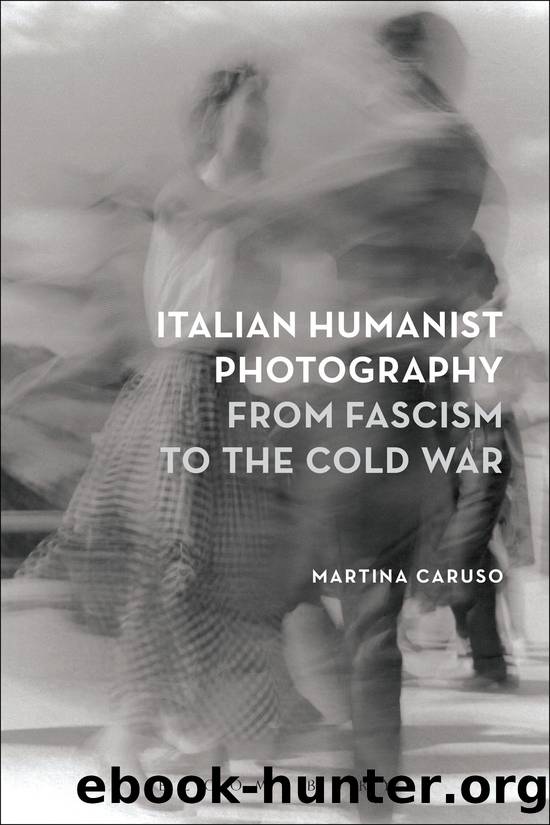Italian Humanist Photography From Fascism to the Cold War by Martina Caruso

Author:Martina Caruso
Language: eng
Format: epub
ISBN: 9781474246941
Publisher: Bloomsbury UK
FIGURE 3.12 Giuseppe Cavalli, Puglia, c. 1950, published in Subjektive Fotografie, 1952. Courtesy Archivio Giuseppe Cavalli.
An empty chair is the protagonist of a quiet, meditative photograph on a sunny southern day, far away from the chaotic scenes of the neorealist genre exemplified in the photojournalist style explored earlier. Needles from a pine tree frame the photograph on the upper edge. The soft diffuse light characteristic of Cavalliâs photographs was due to the milk-like light of the Adriatic coast, different from the dark, more contrasted, light of the Tyrrhenian (West) coast.100 Cavalli came from Puglia originally, and moved to Senigallia, remaining on the east coast and able to continue photographing in his acquired style. Puglia was published in the German photographer Otto Steinertâs annual catalogue Subjektive Fotografie, a veritable bible for Italian photographers in the early 1950s for La Bussola and La Gondola alike.101 Cavalli promoted the work of young photographers and in December 1953 he founded Misa, an off-shoot of La Bussola, in Senigallia.102 Its members would include Mario Giacomelli (the groupâs treasurer), Alfredo Camisa, and Piergiorgio Branzi among others. Although the club maintained Cavalliâs literary-cultural aura, all three photographers developed a high-contrast photography, in which they focused on social issues while paying attention to their formal expression.
Branzi had read Christ Stopped at Eboli and knew about the young peasant author and poet Rocco Scotellaro, who became the mayor of Tricarico in 1946 at the age of twenty-three and had recently published a novel, Southern Peasants (Contadini del Sud) in 1954. Driven by a spirit of curiosity and adventure, Branzi traveled from Florence to the south of Italy in 1955 on a Guzzi motorbike with his brother-in-law.103 Subject to the prejudices of his time, Branzi recalls Cavalli remarking, âWell if youâve gone to the South, you must have become a Communist.â Branzi was not a Communist. Although keeping his worship private and separate from his practice, he had a strong Catholic faith, connected to the radical intelligentsia that grew in Florence after the war. A progressive existential Catholic ideology, embodied in particular by Giorgio La Pira (under whom Branzi studied law in Florence in the early 1950s) and Don Milani, influenced him. Branzi observed that he did not want to dwell on the poverty of the South, but was interested in photographing the dignity of the people. He said he was looking for their âhumanity.â One of his few photographs from his trip (he only had twelve photographs on his Rolleiflex film) shows a young boy with his back to the camera, his thumb pressed against the wall (Figure 3.13).
Download
This site does not store any files on its server. We only index and link to content provided by other sites. Please contact the content providers to delete copyright contents if any and email us, we'll remove relevant links or contents immediately.
Aircraft Design of WWII: A Sketchbook by Lockheed Aircraft Corporation(32139)
The Great Music City by Andrea Baker(30785)
Call Me by Your Name by André Aciman(19912)
The Art of Boudoir Photography: How to Create Stunning Photographs of Women by Christa Meola(18410)
The Secret History by Donna Tartt(18187)
Shoot Sexy by Ryan Armbrust(17560)
Plagued by Fire by Paul Hendrickson(17117)
Portrait Mastery in Black & White: Learn the Signature Style of a Legendary Photographer by Tim Kelly(16873)
Adobe Camera Raw For Digital Photographers Only by Rob Sheppard(16800)
Photographically Speaking: A Deeper Look at Creating Stronger Images (Eva Spring's Library) by David duChemin(16501)
Ready Player One by Cline Ernest(14003)
Pimp by Iceberg Slim(13787)
Bombshells: Glamour Girls of a Lifetime by Sullivan Steve(13691)
The Goal (Off-Campus #4) by Elle Kennedy(13207)
Art Nude Photography Explained: How to Photograph and Understand Great Art Nude Images by Simon Walden(12854)
Kathy Andrews Collection by Kathy Andrews(11329)
The Priory of the Orange Tree by Samantha Shannon(8626)
Thirteen Reasons Why by Jay Asher(8461)
The remains of the day by Kazuo Ishiguro(8402)
